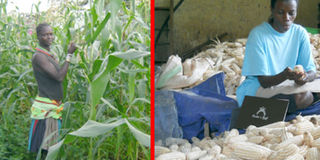Uganda, Kenya set to release new non-GM maize varieties for the market

A woman farmer in Mukono sorts her maize after harvest while another in Karamoja checks on the progress of her crop in the field. The release of drought tolerant varieties is targetted at such smallholder farmers. File photos
What you need to know:
Drought affects many countries in Africa and affects the production of staple crops. The pending release of new drought-tolerant maize varieties is likely to open up new economic opportunities for farmers.
Farmers in Kenya and Uganda could soon start growing conventional drought-tolerant maize once they are approved for commercialisation by the respective regulatory authorities.
This follows several advanced field trials that have been held to test the non-GM maize varieties in Embu, Machakos, Naivasha, and Kakamega in Kenya and Kasese in Uganda.
Counter the effects
Dr Sylvester Oikeh, the project manager, Water Efficient Maize for Africa (Wema) , said one line of the crop is at the final stage of approval and more than 25 others are at different stages of the national performance trials in Kenya compared with eight lines in Uganda.
“The varieties have been undergoing field trials in various parts of Kenya since 2009 and will be available to farmers during the 2013 short-rains season subject to final approvals from the Kenya Plant Health Inspectorate Service,” he said.
He added that like many other countries in Africa, Kenya and Uganda are affected by drought conditions and thus the new maize varieties will help farmers counter the effects that affect their yields.
Maize is the most widely grown staple crop in East Africa.
It is also an important animal feed. According to the National Agricultural Research Organisation (Naro), per capita total maize consumption ranges from 28 kilogrammes a year in Uganda to 125 kilogrammes a year in Kenya.
However, the yields remain low, fluctuating around 1.5 tonnes per hectare in Uganda and 2.3 tonnes per hectare in Kenya, due to a combination of factors including drought, pests and diseases.
Made progress
Dr Godfrey Asea, team leader of Cereals Programme at the National Crops Resources Research Institute, said the drought-tolerant maize in Uganda will either be released to farmers at the end of this year or early next year.
“So far, we have made progress because we now have a number of crops (maize) in the pipeline for release of about eight hybrids lines. They are in the final stages of testing and we hope that the exercise will be completed this year and apply for the release either late this year or early next year,” Dr Asea said.
Release varieties
He added that the release of the new maize variety to the farmers will solve the effects of drought that affects the crops during flowering. Uganda’s Agriculture Seeds and Plant Act requires research institutions to apply for a release of planting materials to the National Plant Variety Committee.
===============================
ABOUT WEMA
The Water Efficient Maize for Africa project aims to address effects of drought and insect pressure in a cost-effective way for smallholder farmers. The goal is to make these varieties available royalty-free through seed companies, with African Agricultural Technology Foundation as the coordinating agency.
CIMMYT and Monsanto are the other partners, working with the Kari and Naro. Kenya produces about 2.7m tonnes per year compared to Uganda’s 1.9m tonnes
The development of drought tolerant maize by WEMA is also being implemented in Tanzania, Mozambique and South Africa




